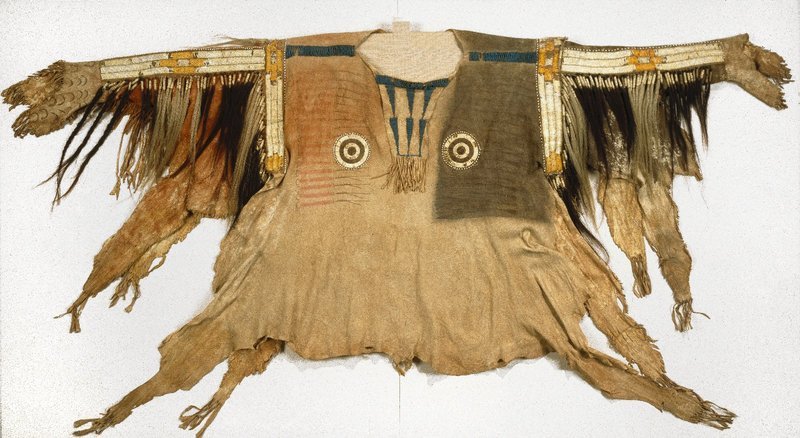Shirt for Chief's War Dress Item Number: 50.67.1a from the Brooklyn Museum



Description
Tailored as an "over-the-head" garment, the shirt is constructed from four pieces of skin (front, back and two sleeves). It is laced together from elbow to wrist on both sides, but the triangular bib is sewn on. Lazy stitch beadwork has been used on the bib and shoulders. Both the front and the back of the shirt are elaborately painted which is unusual. The upper quadrant on the proper left side of the shirt is stained a dark grayish brown, the upper right is smudged with reddish stain. The painted designs on these colored areas probably represent a tally related to war exploits. On the brownish area, sixteen linear objects, possibly stylized rifles, have been drawn in paint, one above the other. On the right, in the area partially stained in red, are seventeen linear designs in brown, bifurcated on the right side that may represent horse quirts. The shirt is also painted on the back with five geometric shapes that almost certainly represent people (torsos are triangular with round heads, but facial features are not indicated). Designs that probably represent horse tracks are on the right lower sleeve in front and on the reverse on the right shoulder. The lower left sleeve at the wrist is decorated with evenly spaced rows of short slashes. The beads used to decorate the shirt are almost entirely large blue and white pony beads, although there are some tube beads on the epaulets and along the sleeve. The porcupine quills are dyed mainly orange and white. The two rosettes on the chest are quilled with brown fern stems and white porcupine quills and are also appliquéd with white pony beads. There are some remnants of white fur on the tips of the fringe at the hip of the shirt. One feather was attached to fringe. Hair locks are made partly of human hair and partly of horsehair dyed blue-green with a few light colored hairs interspersed among the locks. The locks are wrapped at the base with porcupine quills. This shirt is part of an outfit with leggings 50.67.1b, c.
Label
Dr. Nathan Sturges Jarvis, a military surgeon stationed at Fort Snelling, Minnesota, between 1833 and 1836, collected this war shirt as well as matching leggings (not shown). It is one of the finest, earliest Plains pieces in existence. After the explorations of Lewis and Clark, some Native Americans created trade ties with Euro-Americans. As a result, this garment shows Native invention using new materials and symbols in its decoration along with traditional ones.
The lane stitch (sometimes called lazy stitch) has been used on the bib and shoulders. The painted designs on the front of the shirt probably represent a tally related to war exploits, such as the linear shapes on the brown side indicating stylized rifles. On the right, in the area partially stained in red, are seventeen linear designs in brown that may represent horse quirts. The shirt is also painted on the back with five triangular shapes with round heads that almost certainly represent people. Horse track designs are on the right lower sleeve in front and on the reverse on the right shoulder. Horses, rifles, and trade beads are all items brought to the Plains after non-native contact, while hides, quillwork, and painted decoration had been used for decades.
Credit Line
Henry L. Batterman Fund and Frank Sherman Benson Fund
Item History
- Made between 1800 and 1899
What
- Name
- Shirt for Chief's War Dress
- Identification Number
- 50.67.1a
- Type of Item
- shirt, dress and war
- Material
- pony bead, porcupine quill, buckskin, maidenhair fern stem, human hair, horse hair, dye and feather
- Overall
- length 44.0 in, width 68.0 in
Where
- Holding Institution
- Brooklyn Museum
When
- Creation Date
- between 1800 and 1899
Other
- Classification
- Clothing